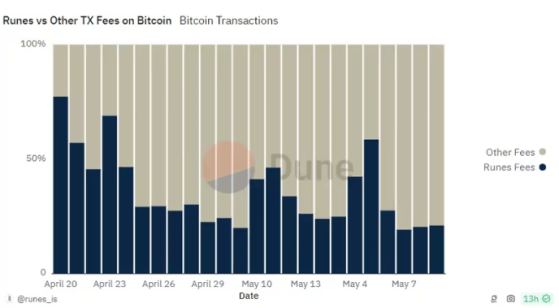The Rise and Fall of Bitcoin Protocol Runes
The Bitcoin protocol Runes, launched on April 20 on the day of the fourth bitcoin halving, started off with impressive results but soon faced a sharp decline in activity. During the first ten days after the launch, Dune Analytics recorded high activity, including the issuance of over 85,000 tokens and the collection of over $3 million in fees. However, over the past two weeks, the indicators have dropped sharply: only about 5,000 new Runes have been issued, and fees totaled less than $100,000.
At its peak of popularity, Runes accounted for up to 80% of all network activity in the Bitcoin ecosystem, but now this figure has dropped to 20%. This decline coincides with a general downturn in the cryptocurrency market, which may have impacted the reduced interest in the protocol.
Runes sparked significant interest even before its launch, with many expecting it to become a significant player in the ecosystem of meme coins, such as those existing on blockchains like Solana and Base. However, despite the initial buzz, experts now believe that more efforts and innovations will be needed for the protocol to further evolve.
Such a sharp decline in activity raises questions about the long-term sustainability and future of Runes. The interest in the new protocol was high, but its future will depend on the team’s ability to maintain user interest and adapt to changing conditions in the cryptocurrency market.





